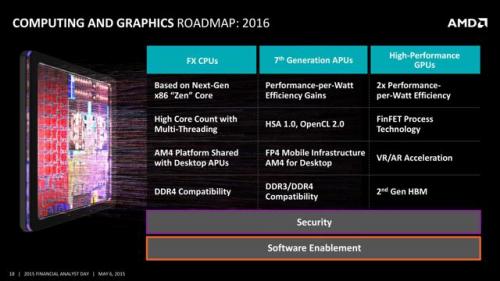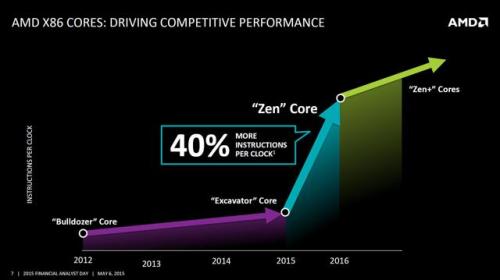英特尔Skylake与AMD Zen正面pk,毫无悬念?
it will be able to outperform GPUs like GeForce 940M and it will be able to face something like an AMD M370X (Macbook Pro Retina 15') or slightly better.
Given this scenario, the eDRAM makes possible to decently play games and drive professional 3D programs if the 3D project is not excessively heavy. Even from the price point of view, there is only a small difference since the i7 6650U costs just $22 more than i7 6500U or i7 6600U while the i5 6260U and i5 6360U cost just $23 more than i5 6200U and i5 6300U.
This means one thing: What you have seen in the previous chart was simply meaningless, because Intel has clearly raised the bar with the eDRAM addition, which enables it to massively outperform AMD in the 15W mid-end and high-end solutions. This kind of performance difference was quite unthinkable just last year.
Zen
What about the Zen architecture? The server Zen SoCs will be released in Q4 2016 (with market product presence in H1 2017) while the desktop and laptop solutions will be released in mid-2017. These SoCs will provide a better IPC by 40% (but we know that such high claims hardly meet reality) and they will be built with a 14nm node technology, achieving a high core count (however, the sources state that Zen will adopt 2 cores for 5-15W and 4 cores for 15-35W). Will this be enough to reach Intel? Sincerely, I do not think so.

ZEN IPC
Intel will release two new architectures in 2016 (Kaby Lake) and in 2017 (Cannonlake); in addition, it will release two new GPU architectures at the same time. INTC is also planning to release Cannonlake at 10nm and to double the core count, projecting to also increase eDRAM adoption.

If we want to consider HBMs, such a technology is not suitable for integrated GPUs, because these SoCs do not have feeding requirements even comparable to discrete high-performance GPUs. Moreover, Intel could still adopt 3D XPoint and MCDRAM to face an eventual AMD HBM SoC adoption.
Given these points, it is very difficult to see competitive results from AMD's Zen architecture. It will certainly be a nice improvement, but from what AMD has already disclosed, its chances to provide a really competitive solution are still very low.
Conclusion
Steamroller/Carrizo APUs cannot change AMD's fate, even in this generation. The relative CPU improvement is similar to what Skylake is showing at the same TDP while the GPU comparison looks worse than expected. Intel HD Graphics Gen9 has improved graphics performance at a major rate compared to AMD, tipping the balance towards its favor.
AMD has obviously achieved good results, reducing the TDP by 20% and improving performances, but Intel HD Graphics simply grew much more. If we also consider Intel's eDRAM solutions, INTC clearly owns the medium- and high-performance segments without any doubts.
In my opinion, AMD has no chance of achieving relevant market share, and it will continue to register losses in the laptop and desktop segment through 2016. There is still little hope for the Zen architecture since the last cash infusion will permit AMD to release it in 2017, but if we consider AMD's claims and Intel's potential for the following years, it is frankly really hard to see the Sunnyvale company living better times in future. Even the chance to see Apple's (NASDAQ:AAPL) devices running AMD's SoCs (custom or Zen) looks quite unlikely to happen.
In any case, I do not exclude that Apple is evaluating this route, but at the same time AAPL is evaluating Intel to build future modems and application processors to p
AMD 英特尔 Skylake SoC ZEN Carrizo 相关文章:
- 中国正探寻如何快速进驻HPC芯片领域(03-23)
- 一季度AMD全球处理器市场份额遭英特尔蚕食(07-01)
- 显卡市场份额之争 AMD逐渐让位NVIDIA(08-04)
- AMD 2016-2017 x86处理器路线图曝光(05-08)
- AMD结合显示与传统芯片力拚数据中心市场(05-18)
- 通过创新架构和电源技术提升处理器能效(08-05)
